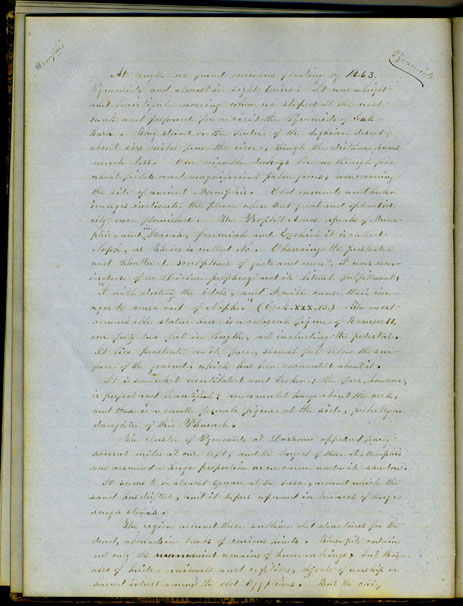Travel
Diary of Mrs. R.P. Eaton:
Europe,
Egypt, and Palestine, ca. 1857

(“Memphis” in upper left corner, “Pyramids” in
upper right corner)
At length we found ourselves floating by 1063. Pyramids and almost in
sight Cairo. It was a bright and beautiful morning when we stopped at
the west bank and prepared for a visit the Pyramids of Sakharm. They stand
on the leader of the Sephian desert, about six miles from the river, though
the distance seems much less. Our nimble donkeys have us through fine
wheat-fields and magnificent palm groves, now covering the site of ancient
Memphis. Old mounds and broken images indicate the place where that great
and splendid city once flourished. The Prophet Amos speaks of Memphis,
and in Isaiah, Jeremiah, and Ezekiel it is called Noph, as Thebes is called
No. Observing the prostrate and shattered sculptures of gods and men,
I was reminded of a Divine prophecy and its literal fulfillment; “I
will destroy the idols, and I will cause their images to cease out of
Noph.” (Ezek.XXX.13.). The most remarkable statue here is a colossal
figure of Nemeses II over forty-two feet in length, not including the
pedestal. It lies prostrate on its face several feet below the surface
of the grounds which had been excavated about it.
It is somewhat mutilated and broken; the face, however, is perfect and
beautiful; an amulet hangs about the neck, and there is a small female
figure at the side, probably a
daughter of this Pharaoh.
The cluster of Pyramids at Dashaur appeared finely several miles at our left, and the largest of these at Memphis now assumed a huge proportion as we came and its shadow. It seems to be almost square at the base, around which the sand has drifted, and it tapers upward in terraces of large rough stones.
The region around these sublime old structures for the dead, abounds in tombs of curious kinds. These pits contain not only the resurrected remains of human kings, but those also of birds, animals, and reptiles, objects of worship or sacred interest among the old Egyptians. But the chief